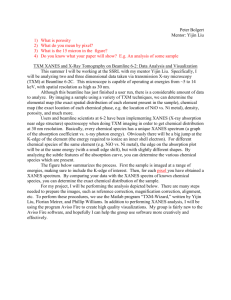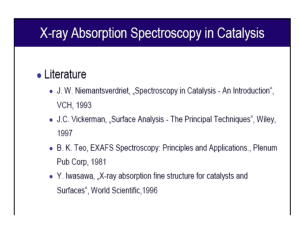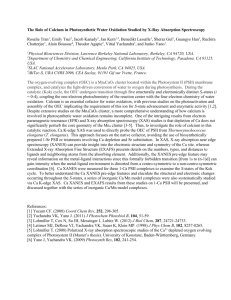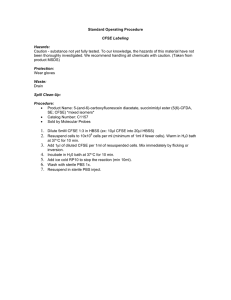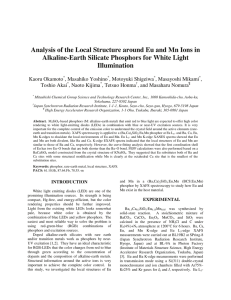20. Breakthroughs in Synchrotron Radiation in Mineralogy
advertisement
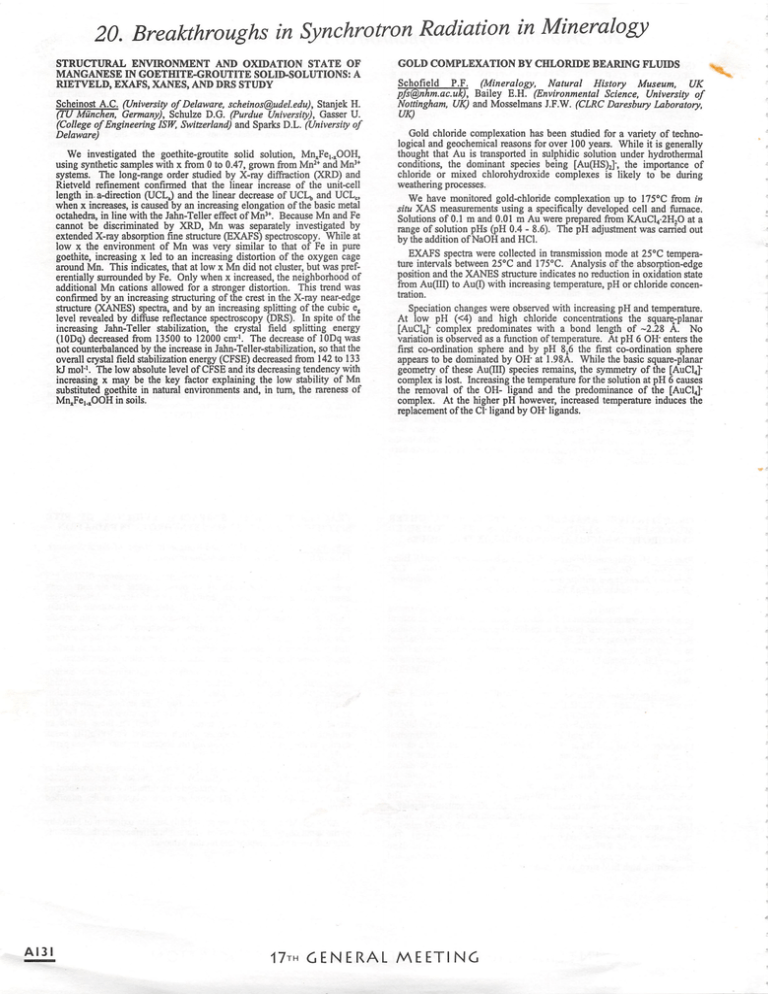
20. Breakthroughs in Synchrotron Radiation in Mineralogy S T R U C T U R A L E N V I R O N M E N T A N D O X T O AT I O N S TAT E O F MANGANESE IN GOETHITE-GROUTITE SOLDtt-SOLUTIONS: A S c h o fi e l d P. F. ( M i n e r a l o g y, N a t u r a l H i s t o r y M u s e u m , U K RIETVELD, EXAFS, XANES, AND DRS STUDY Scheinost A.C. (University of Delaware, scheinos@udel.edu), Stanjek H. prU Miinchen, Germany), Schulze D.G. (Purdue University), Gasser U. (College of Engineering ISW, Switzerland) and Sparks D.L. (University of Delaware) We investigated the goethite-groutite solid solution, Mn.Fe|.,OOH, using synthetic samples with x from 0 to 0.47, grown from Mn^* and Mn'* systems. The long-range order studied by X-ray diffraction POU)) and Rietveld refinement confinned that the linear increase of the unit-cell length in. a-direction (UCLJ and the linear decrease of UCl,, and UCL„ when X increases, is caused by an increasing elongation of the basic metal octahedia, in line with the Jahn-Teller effect of Mn'*. Because Mn and Fe cannot be discriminated by XRD, Mn was separately investigated by extended X-ray absorption fine structure (EXAFS) spectroscopy. While at low X the environment of Mn was very similar to that of Fe in pure goethite, increasing x led to an increasing distortion of the oxygen cage around Mn. This indicates, that at low x Mn did not cluster, but was pref erentially surrounded by Fe. Only when x increased, the neighborhood of additional Mn cations allowed for a stronger distortion. This trend was confirmed by an increasing structuring of the crest in the X-ray near-edge structure (XANES) spectra, and by an increasing splitting of the cubic e, pfs@nhm.ac.uk). Bailey E.H. (Environmental Science, University of Nottingham, UK) and Mosselmans J.F.W. (CLRC Daresbury Laboratory, UK) Gold chloride complexation has been studied for a variety of techno logical and geochemical reasons for over 100 years. While it is generally thought that Au is transported in sulphidic solution under hydrothermal conditions, the dominant species being [Au(HS)2]', the importance of chloride or mixed chlorohydroxide complexes is likely to be during weathering processes. We have monitored gold-chloride complexation up to 175°C from in situ XAS measurements using a specifically developed cell and furnace. Solutions of 0.1 m and 0.01 m Au were prepared from KAuCl4-2H20 at a range of solution pHs (pH 0.4 - 8.6). The pH adjustment was carried out by the addition of NaOH and HCl. EXAFS spectra were collected in transmission mode at 25°C tempera ture intervals between 25°C and 175°C. Analysis of the absorption-edge position and the XANES structure indicates no reduction in oxidation state fh)m Au(III) to Au(I) with increasing temperature, pH or chloride concen tration. Speciation changes were observed with increasing pH and temperature. level revealed by diffiise reflectance spectroscopy (DRS). In ^ite of the At low pH (<4) and high chloride concentrations the square.-planar increasing Jahn-Teller stabilization, the crystal field splitting energy (lODq) decreased from 13500 to 12000 cm-'. The decrease of lODq was not counterbalanced by the increase in Jahn-Teller-stabilization, so that the overall crystal field stabilization energy (CFSE) decreased from 142 to 133 kj mol"'. The low absolute level of CFSE and its decreasing tendency with increasing x may be the key factor explaining the low stability of Mn [AuClJ' complex predominates with a bond length of ~2.28 A. No substituted goethite in natural environments and, in turn, the rareness of Mn,Fe,.,OOH in soils. A I 3 I G O L D C O M P L E X AT I O N B Y C H L O R I D E B E A R I N G F L U I D S 17th general variation is observed as a function of temperature. At pH 6 OH" enters the first co-ordination sphere and by pH 8,6 the first co-ordination sphere appears to be dominated by OH" at 1.98A. While the basic square-planar geometry of these Au(I^ species remains, the symmetty of the [AuClJ- complex is lost. Increasing the temperature for the solution at pH 6 causes the removal of the OH- ligand and the predominance of the [AuClJcomplex. At the higher pH however, increased temperature induces the replacement of the 01- ligand by OH" ligands. meeting

